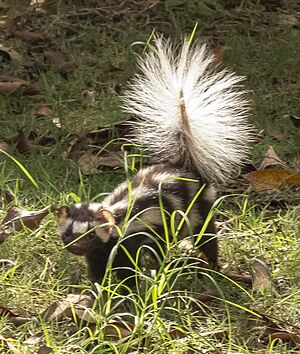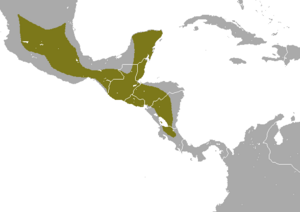Southern spotted skunk facts for kids
Quick facts for kids Southern spotted skunk |
|
|---|---|
 |
|
| In Yucatán, Mexico | |
| Conservation status | |
| Scientific classification | |
| Genus: |
Spilogale
|
| Species: |
angustifrons
|
 |
|
|
Southern spotted skunk range
|
|
The southern spotted skunk (Spilogale angustifrons) is a small, furry animal. It belongs to the skunk family. You can find these skunks from Costa Rica all the way up to southern Mexico. Long ago, some people thought it was just a type of eastern spotted skunk.
What Does It Look Like?
The southern spotted skunk is about 34 centimeters (13 inches) long. Its tail adds another 23 centimeters (9 inches) to its length. This skunk weighs between 0.5 and 1 kilogram (1 to 2 pounds).
It has a striking black and white coat. This makes it easy to spot! It looks a lot like the western spotted skunk. Like other skunks, it has special glands under its tail. These glands can spray a strong-smelling liquid called musk. The skunk sprays this musk to protect itself from animals that might try to hurt it.
Where Do They Live?
The southern spotted skunk lives in Central America. Its home includes countries like Mexico, Guatemala, Honduras, El Salvador, Nicaragua, Costa Rica, and Belize.
These skunks prefer dry, rocky areas. They also live in places with scrub bushes and open woodlands. You can find them in farm areas too. They live at heights up to 300 meters (about 984 feet) above sea level.
How Do They Behave?
The southern spotted skunk is a shy animal. It is also nocturnal, meaning it is active mostly at night. It can climb trees, but it usually looks for food on the ground.
These skunks eat many different things. Their diet includes small mammals, insects, and birds. They also enjoy eating eggs, grains, and various fruits.
Is This Skunk Safe?
The southern spotted skunk faces some challenges. Human activities can affect their homes. Building roads and wildfires are two examples. Also, large farms that grow only one type of crop can change their habitat.
Even though it is not super common, this skunk lives in a very large area. Scientists believe there are many of them in total. They can also adjust to changes in their environment. Because of this, the International Union for Conservation of Nature says the southern spotted skunk is of "least concern". This means it is not currently at risk of disappearing.


